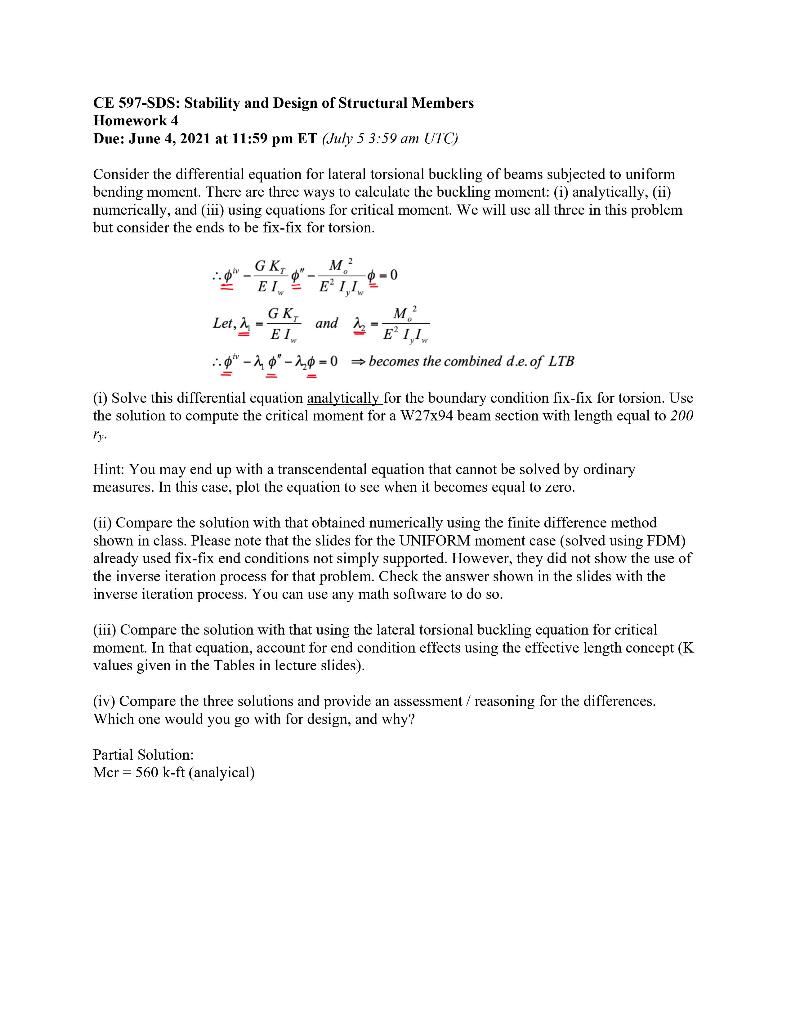PLEASE ANSWER EACH PART ON A DIFFERENT SHEET OF PAPER.
NEAT AND CLEAN SOLUTION ALSO PLEASE.

CE 597-SDS: Stability and Design of Structural Members Homework 4 Due: June 4, 2021 at 11:59 pm ET (July 53:59 am UTC) Consider the differential equation for lateral torsional buckling of beams subjected to uniform bending moment. There are three ways to calculate the buckling moment: (i) analytically, (ii) numerically, and (iii) using equations for critical moment. We will use all three in this problem but consider the ends to be fix-fix for torsion. EL, GK M "- EL GK Let, 1 - and - ELI ..0"-"-20 - 0 becomes the combined d.e. of LTB M (1) Solve this differential equation analytically for the boundary condition ix-fix for torsion. Use the solution to compute the critical moment for a W27x94 beam section with length equal to 200 Hint: You may end up with a transcendental equation that cannot be solved by ordinary measures. In this case, plot the equation to see when it becomes equal to zero. (ii) Compare the solution with that obtained numerically using the finite difference method shown in class. Please note that the slides for the UNIFORM moment case (solved using FDM) already used fix-fix end conditions not simply supported. However, they did not show the use of the inverse iteration process for that problem. Check the answer shown in the slides with the inverse iteration process. You can use any math software to do so. (iii) Compare the solution with that using the lateral torsional buckling equation for critical moment. In that equation, account for end condition effects using the effective length concept (K values given in the Tables in lecture slides). (iv) Compare the three solutions and provide an assessment / reasoning for the differences. Which one would you go with for design, and why? Partial Solution: Mer = 560 k-ft (analyical) CE 597-SDS: Stability and Design of Structural Members Homework 4 Due: June 4, 2021 at 11:59 pm ET (July 53:59 am UTC) Consider the differential equation for lateral torsional buckling of beams subjected to uniform bending moment. There are three ways to calculate the buckling moment: (i) analytically, (ii) numerically, and (iii) using equations for critical moment. We will use all three in this problem but consider the ends to be fix-fix for torsion. EL, GK M "- EL GK Let, 1 - and - ELI ..0"-"-20 - 0 becomes the combined d.e. of LTB M (1) Solve this differential equation analytically for the boundary condition ix-fix for torsion. Use the solution to compute the critical moment for a W27x94 beam section with length equal to 200 Hint: You may end up with a transcendental equation that cannot be solved by ordinary measures. In this case, plot the equation to see when it becomes equal to zero. (ii) Compare the solution with that obtained numerically using the finite difference method shown in class. Please note that the slides for the UNIFORM moment case (solved using FDM) already used fix-fix end conditions not simply supported. However, they did not show the use of the inverse iteration process for that problem. Check the answer shown in the slides with the inverse iteration process. You can use any math software to do so. (iii) Compare the solution with that using the lateral torsional buckling equation for critical moment. In that equation, account for end condition effects using the effective length concept (K values given in the Tables in lecture slides). (iv) Compare the three solutions and provide an assessment / reasoning for the differences. Which one would you go with for design, and why? Partial Solution: Mer = 560 k-ft (analyical)







